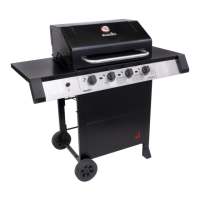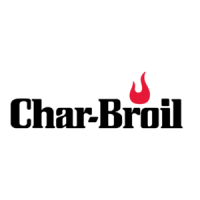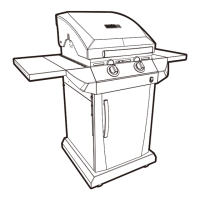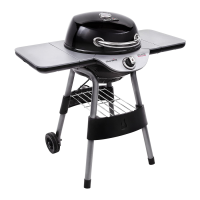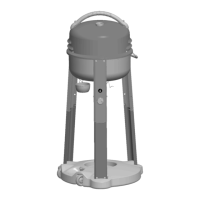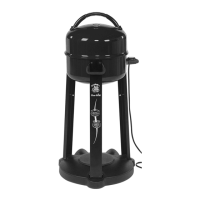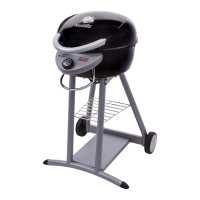7
Cleaning the Burner Assembly Storing Your Appliance
Follow these instructions to clean and/or replace
parts of burner assembly or if you have trouble
igniting appliance.
1. Turn gas off at control knobs and cylinder.
2. Remove cooking grates, flame tamers, carryover
tubes and burners.
3. Detach electrode from burner.
4. Carefully lift each burner up and away from valve
openings.
5. We suggest three ways to clean the burner
tubes. Use the one easiest for you.
(A) Bend a stiff wire (a light weight coat hanger
works well) into a small hook. Run the hook
through each burner tube several times.
(B) Use a narrow bottle brush with a flexible
handle (do not use a brass wire brush), run the
brush through each burner several times.
(C) Wear eye protection: Use an air hose
to force air into burner tube and out burner
ports. Check each port to make sure air
comes out each hole.
6. Wire brush entire outer surface of burner to
remove food residue and dirt.
7. Clean any blocked ports with a stiff wire such as
an open paper clip.
8. Check burner for damage, due to normal wear
and corrosion some holes may become enlarged.
If any large cracks or holes are found, replace
burner.
VERY
IMPORTANT:
Burner tubes must
reengage valve
openings. See
illustration.
Correct burner-tovalve engagement
9. Attach electrode to burner.
10. Carefully replace burners.
11. Attach burners to brackets on firebox.
12. Reposition carryover tubes and attach
to burners. Replace flame tamers and cooking
grates.
•Clean cooking grates.
•Store in dry location.
•When gas cylinder is connected to appliance, store
outdoors in a well-ventilated space and out of reach
of children.
•Cover appliance if stored outdoors.
•Store appliance indoors ONLY if gas cylinder is
turned off and disconnected, removed from
appliance and stored outdoors.
•When removing appliance from storage check for
burner obstructions.
General Appliance Cleaning
•Clean appliance often, preferably after each
cookout. If a bristle brush is used to clean any of
the appliance cooking surfaces, ensure no loose
bristles remain on cooking surfaces prior to grilling.
It is not recommended to clean cooking surface
while appliance is hot. Appliance should be
cleaned at least once a year.
•Do not mistake brown or black accumulation of
grease and smoke for paint. Interiors of gas grills
are not painted at the factory (and should never be
painted). Apply a strong solution of detergent and
water or use a appliance cleaner with scrub brush
on insides of appliance lid and bottom. Rinse and
allow to completely air dry. Do not apply caustic
appliance/oven cleaner to painted surfaces.
• Plastic parts: Wash with warm soapy water and
wipe dry. • Do not use citrisol, abrasive cleaners,
degreasers or a concentrated appliance cleaner
on plastic parts. Damage to and failure of parts
can result.
•Porcelain surfaces: Because of glass-like
composition, most residue can be wiped away with
baking soda/water solution or specially formulated
cleaner. Use nonabrasive scouring
Høyre
skinne powder for stubborn stains.
•Painted surfaces: Wash with mild detergent or
nonabrasive cleaner and warm soapy water. Wipe
dry with a soft nonabrasive cloth.
•Stainless steel surfaces: To maintain your
appliance’s high quality appearance, wash with
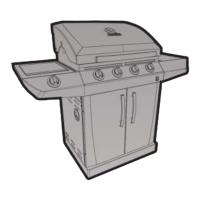
